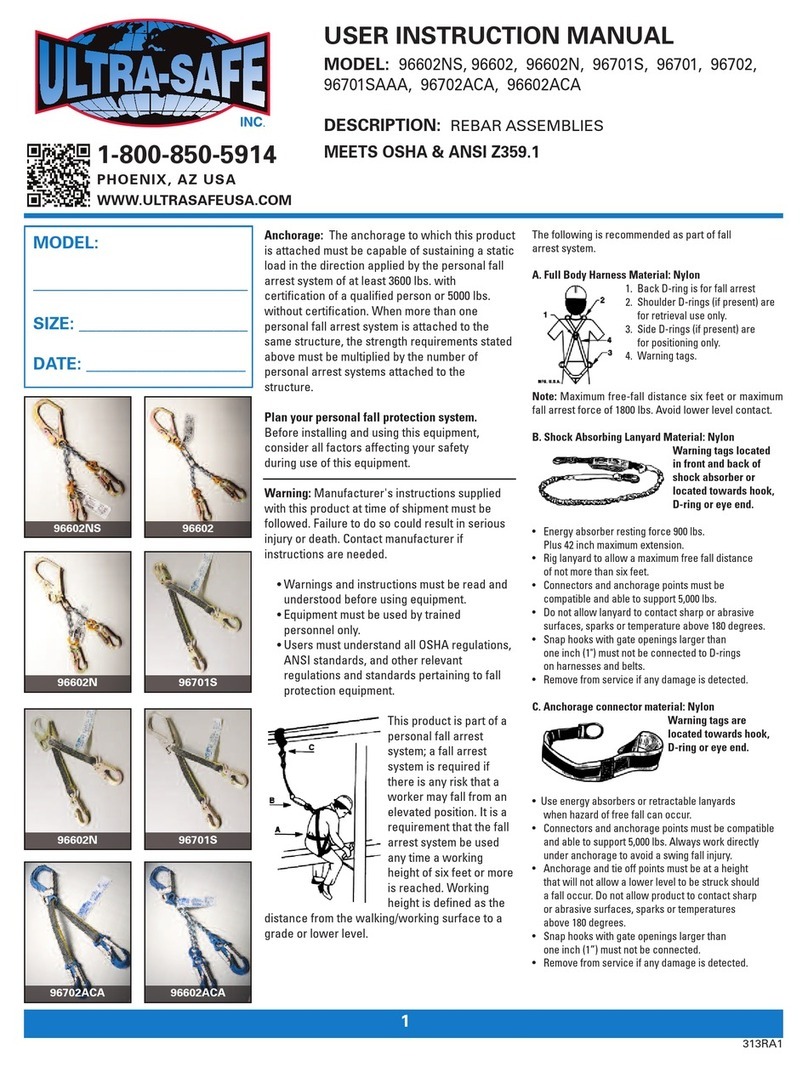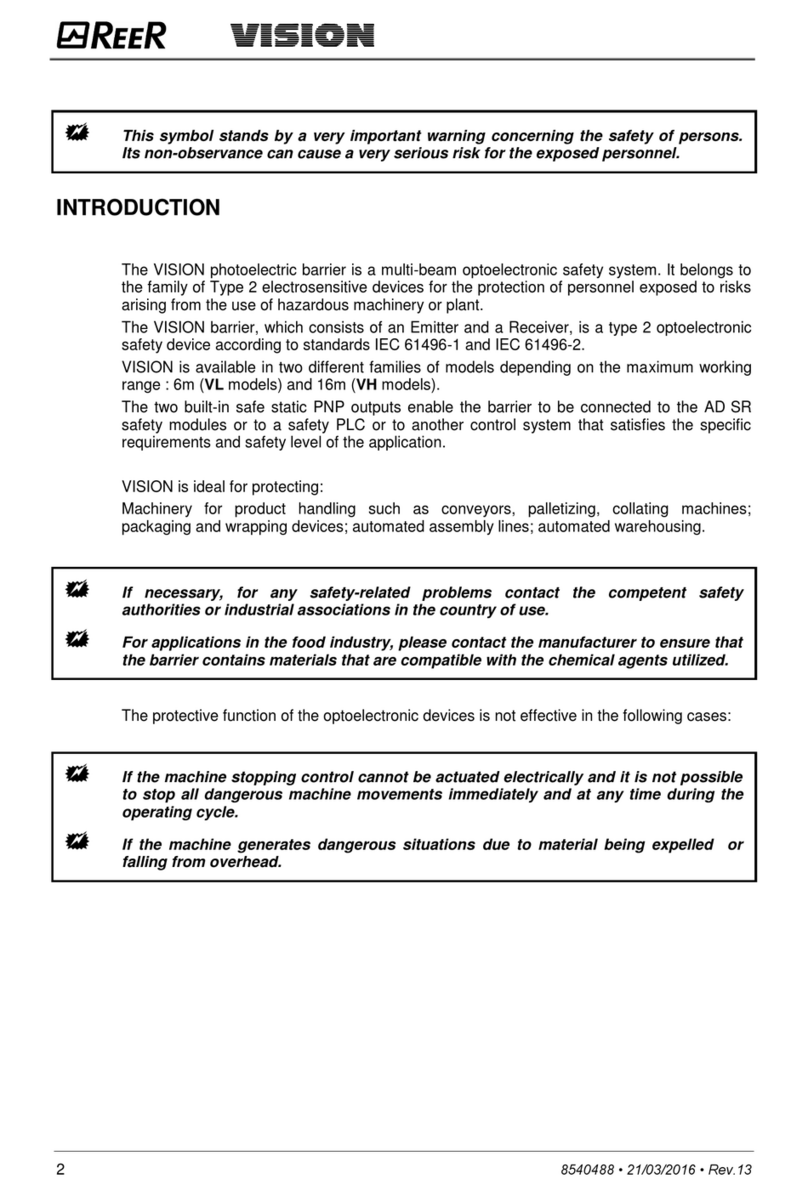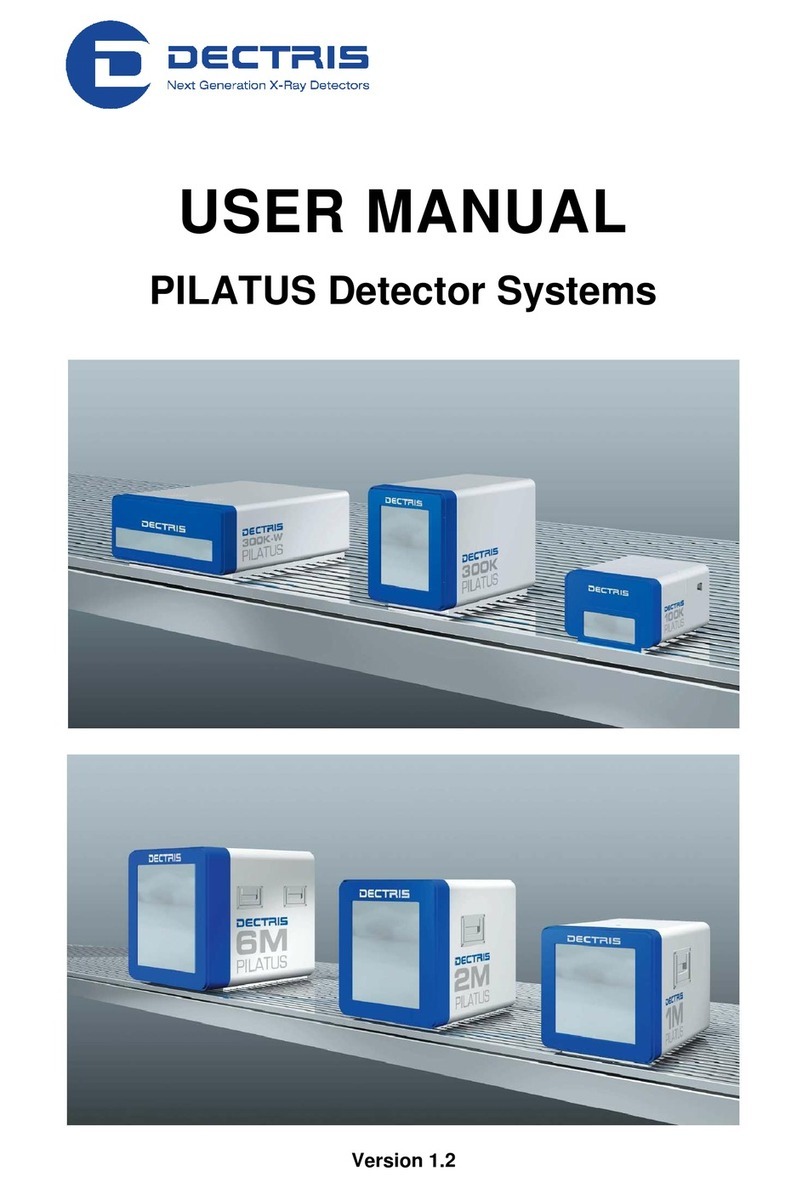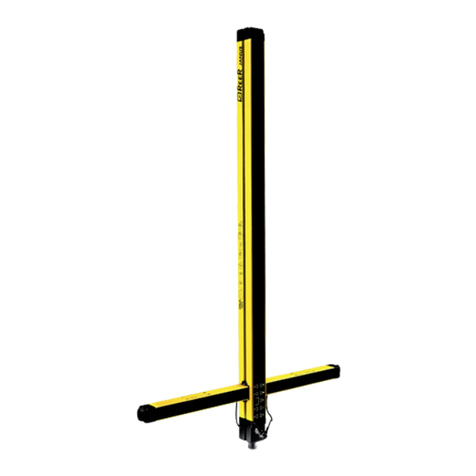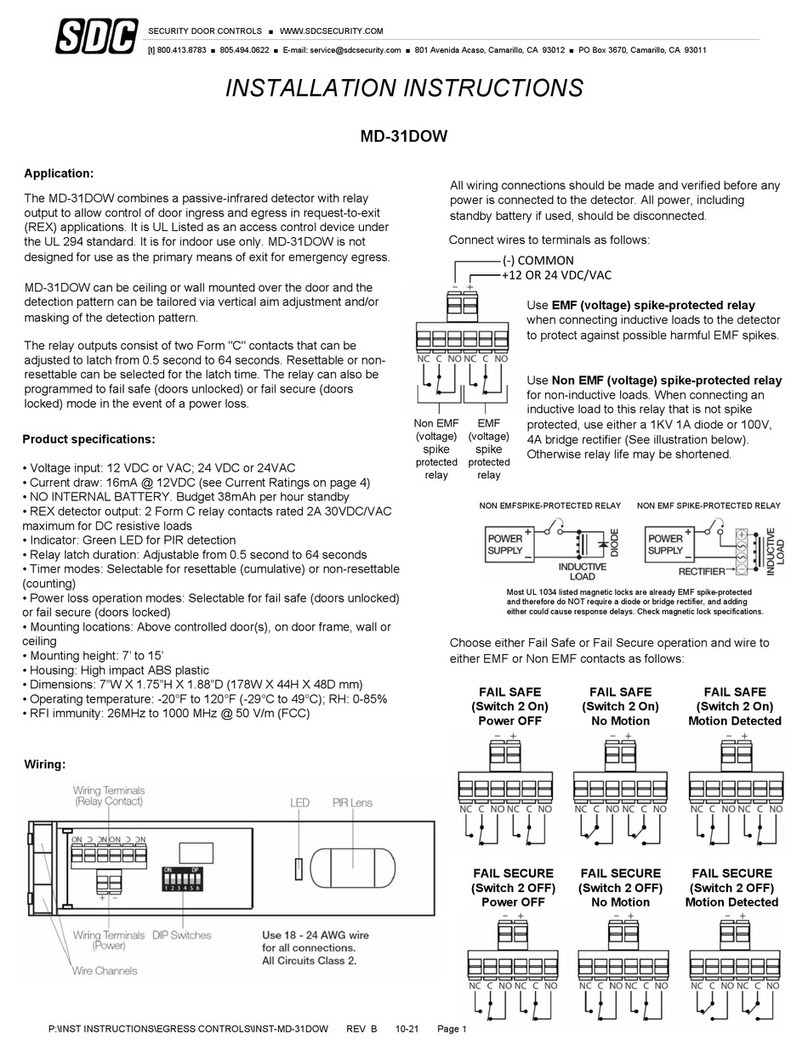ironwear 2100 User manual

Full Body Harness
INSTRUCTION MANUAL
These instructions apply to the following model(s) manufactured after Jan 1st, 2018:
2100 Full body harness with three D-rings
2125 Full body harness with three D-rings
2150 Full body harness with three D-rings & Waist Support
UNDER PENALTY OF LAW
This manual must be read and understood in its entirety and used as part of a fall protection training program, as required by OSHA or
any state/local regulatory agencies.
This manual is intended to meet industry standards required by ANSI Z359.11-2014 Fall Protection Code. The user must read and fully
understand the limitations and proper use of the equipment and be properly trained by the employer prior to use.
NOTE: This User Instruction Manual is not to be removed except by the equipment user. Current User Instruction Manuals must always
be available to the user. Read and understand these instructions before using equipment. Do not discard these instructions.
PURPOSE
IRONWEAR Full Body Harnesses are Class 3 full body harnesses designed for an array of full-body applications. Such full body
harnesses are the only form of body wear acceptable for fall arrest. Full body harnesses may also be used for positioning, travel restraint,
and rescue.
IRONWEAR Harnesses are designed and tested to comply with applicable OSHA and ANSI standards for fall protection equipment.
When used as a component in a personal fall arrest system or personal restraint system, IRONWEAR Full Body Harnesses comply with
OSHA directives for fall protection wear. Full body harnesses serve to better distribute the forces of a fall to suitable areas of a body and
keep the body upright should a fall occur. Application
Personal Fall Arrest: The full body harness is used as
a component of a personal fall arrest system. Personal
fall arrest systems typically include a full body harness
and a connecting subsystem (energy absorbing lanyard).
Maximum arresting force must not exceed 900 lbs (4
KN), for fall arrest applications connect the fall arrest
subsystem (example: lanyard, SRL, energy absorber,
etc.) to the D-ring or attachment element on your back,
Work Positioning: The full body harness is used as a
component of a work positioning system to support the
user at a work position. Work positioning systems
typically include a full body harness, positioning
lanyard, and a back-up personal fall arrest system. For
work positioning applications, connect the work
positioning subsystem (example: lanyard, Y-lanyard,
etc.) to the lower (hip level) side or belt mounted work

between your shoulder blades. positioning attachment anchor-age elements (D-rings).
Never use these connection points for fall arrest.
Rescue: The full body harness is used as a component
of a rescue system. Rescue systems are configured
depending on the type of rescue. For limited access
(confined space) applications, harnesses equipped with
D-rings on the shoulders may be used for entry and
egress into confined spaces where worker profile is an
issue.
Controlled Descent: For controlled descent
applications, full body harnesses equipped with a single
sternal level D-ring, one or two frontal mounted
D-rings, or a pair of connectors originating below the
waist (such as a seat sling) may be used for connection
to a descender or evacuation system.
Restraint: The full body harness is used as a
component of a restraint system to prevent the user from
reaching a fall hazard. Restraint systems typically
include a full body harness and a lanyard or restraint
line.
Instructions For Use
■ Failure to follow all instructions and limitations on the use of this equipment may result in serious personal injury or death.
■ Prior to each use, inspect all personal fall arrest system equipment for wear, damage, and other deterioration. Defective components
must be removed from service immediately.
■ After a fall, the IRONWEAR Full Body Harness must be removed from service and destroyed immediately.
■ Thoroughly evaluate and plan all elements of your fall protection system(s) before using your equipment. Make sure that your system is
appropriate for your needs and facility. Also, be sure to calculate fall clearance and swing fall clearance.
■ Users must have a rescue plan and the means to implement it. This plan must provide prompt employee rescue or assure that employees
have the ability to rescue themselves in the event of a fall.
■ Store this equipment in a cool, dry, and clean environment that is out of direct sunlight when not in use.
■ After a fall occurs, this equipment must be removed from service and destroyed immediately.
■ Failure to follow all instructions and limitations on the use of Personal Energy Absorbers and Energy Absorbing Lanyards may result in
serious personal injury or death.
■ Failure to have the leg straps of the Full Body Harness properly adjusted in the event of a fall arrest may result in serious personal
injury or death.
■ Never attach the unused leg of the lanyard back to the IRONWEAR Full Body Harness anywhere other than an approved lanyard
storage keeper.
■ To minimize the potential for accidental disengagement, a Competent Person must ensure system compatibility.
■ All equipment must be inspected before each use according to the instructions found in this User Instruction Manual. All equipment
should be inspected by a qualified person on a regular basis.
■ Never use fall protection equipment for purposes other than those for which it was designed.
■ Environmental hazards should be considered when selecting fall protection equipment.
■ Do not expose the equipment to any hazard which it is not designed to withstand. Consult IRONWEAR in cases of doubt.
■ Never remove product labels because they include important information for the Authorized Person/User.
MATERIALS AND CONSTRUCTION
Webbing Materials: High tenacity polyester; breaking strength >5000 lbs. tensile strength
Pad and Label Cover Materials: Nylon and polyester blend
Connector Materials: Alloy Steel
Limitations For Use
■ This equipment is designed to be used in temperatures ranging from -40ºF to +130ºF (-40°C to +54°C).
■ Do not expose this equipment to chemicals or harsh solutions that may have a harmful effect. Contact IRONWEAR with any
questions.
■ Use caution when working with this product near moving machinery, electrical hazards, sharp edges, or abrasive surfaces, as contact

may cause equipment failure, personal injury, or death.
■ Minors, pregnant women, and anyone with a history of back and/or neck problems should not use this equipment.
■ Do not use or install equipment without proper training from a “Competent Person”.
■ Only IRONWEAR, or entities authorized in writing by IRONWEAR, shall make repairs or alterations to the equipment.
■ IRONWEAR Full Body Harnesses are designed for users with a maximum capacity up to 310 lb.* (141 kg.) including clothing, tools,
etc.*If the system is used by an employee having a combined tool and body weight between 310 lb. (140.6 kg.) and 400 lb. (181.4 kg.),
then the employer must appropriately modify the criteria and protocols to provide proper protection for such heavier weights, or
the system will not be deemed to be in compliance with the requirements of OSHA 1926.502(d) (16). [ANSI capacity range is 130
lb. – 310 lb. (59 kg. – 140.6 kg.).]
■ Personal Energy Absorbers and Energy Absorbing Lanyards marked with, “ANSI Z359.13,” and “6 ft. Free Fall” are designed for up
to 6 ft. free fall applications with a maximum capacity up to 310 lb. (141 kg) including clothing, tools, etc.
■ IRONWEAR Full Body Harnesses shall be used as part of a personal fall arrest system that limits the maximum free fall distance to 6
ft. (1.8 m). If used with appropriate connecting system, IRONWEAR Full Body Harnesses may be used with free falls exceeding 6 ft.
(1.8 m).
■ Full Body Harnesses shall only be used as part of a controlled descent or rescue system that eliminates free fall unless attached to the
dorsal D-ring. When attached to the dorsal D-ring, the maximum free fall distance is 6 ft. (1.8 m).
■ Full Body Harnesses shall only be used as part of a work positioning system that limits the maximum free fall distance to 2 ft. (0.6 m).
■ Only use components rated for the same weight capacity. Not all fall protection components are rated for the same user weight
capacity.
■ Proper precautions should always be taken to remove any obstructions, debris, material, or other recognized hazards from the work
area that could cause injuries or interfere with the effective operation of the system.
■ Do not use fall protection equipment for towing or hoisting.
■ Protect all synthetic material from slag, hot sparks, open flames, or other heat sources.
■ Do not expose equipment to environmental hazards and chemicals which may produce a harmful effect. Polyester should be used in
certain chemical or acidic environments.
■ Do not allow equipment to come in contact with anything that will damage it including (but not limited to): sharp edges, abrasive
surfaces, moving machinery, or high-temperature applications like welding, heat sources, and electrical areas.
■ Evaluate space below work area to ensure potential fall path is clear of obstructions.
■ Allow adequate fall clearance below the work surface.

Anchorage Requirements
All anchorages to which the Personal Energy Absorbers and Energy Absorbing Lanyards attach must meet the requirements of ANSI
Z359.1-2007:
Anchorages to which personal fall arrest equipment is attached shall be capable of supporting at least 5,000 lb. (22.2 KN) per employee
attached, or shall be designed, installed, and used as part of a complete personal fall arrest system which maintains a safety factor of at
least two, under the supervision of a qualified person.
ANSI Z359.1-2007 states that anchorages in a personal fall arrest system must have strength capable of sustaining static loads applied in
all directions permitted by the system of at least:
(a) Two times the maximum arrest force permitted on the system with certification, or
(b) 5,000 lb. (22.2 KN) in the absence of certification
When more than one personal fall arrest system is attached to the anchorage, the strength in (a) and (b) must be multiplied by the number
of personal fall arrest systems attached to the anchorage.
Anchorages used in controlled descent and rescue systems must be capable of supporting loads of 3,100 ft-lb. (13.8 KN) for non-certified
anchorages or a 5:1 safety factor for certified anchorages per ANSI Z359.4-2007.
Anchorages used in restraint systems must be capable of supporting loads of 1,000 ft-lb. (4.5 KN) for non-certified anchorages or two
times the foreseeable force for certified anchorages per ANSI Z359.2-2007.
Anchorages used in work positioning systems must be capable of supporting loads of 3,000 ft-lb. (13.3 KN) for non-certified anchorages
or two times the foreseeable force for certified anchorages per ANSI Z359.2-2007.
Anchorages should be located as vertically as possible above the user’s head and be positioned as not to exceed the maximum allowable
free fall for the system.
Connection Compatibility Limitations
All IRONWEAR equipment must be coupled to compatible connectors. OSHA 29 CFR 1926.502 prohibits snap hooks from being
engaged to certain objects unless two requirements are met:
1. It must be a locking type snap hook.
2. It must be “designed for” making such a connection.
a. “Designed for” means that the manufacturer of the snap hook specifically created the snap hook to be used to connect to the
equipment in question.
The following conditions can result in rollout* when a non-locking snap hook is used. Avoid the following connections:
■ Direct connection of a snap hook to horizontal lifeline.
■ Two (or more) snap hooks connected to one D-ring.
■ Two snap hooks connected to each other.
■ A snap hook connected back on its integral lanyard.
■ A snap hook connected to a webbing loop or webbing lanyard.
■ Improper dimensions of the D-ring, rebar, or other connection point in relation to the snap hook dimensions that would allow the snap
hook keeper to be depressed by a turning motion of the snap hook.
* Rollout: A process by which a snap hook or carabiner unintentionally disengages from another connector or object to which it is
coupled. (ANSI Z359.0-2007)
Fall Clearance/Clear Fall Charts
Free Fall:
Maximum free fall distance allowed for use in a PFAS is six feet. For use in a Restraint or Rescue System, no free fall is permitted. For
use in a Work Positioning System, maximum free-fall distance allowed is two feet. Do not work above the anchorage level to avoid
increased Free Fall Distance.

Fall Arrest Forces:
Full Body Harnesses which meet Z359.11-2014 and Z359.3 are intended to be used with other components of a Personal Fall Arrest
System that limit maximum arrest forces to 1800 pounds (8 KN) or less. Deceleration distance should not be allowed to exceed 48
inches.
Swing Falls:
To minimize the possibility of a swing fall, work as directly under the anchorage connector as possible. Striking objects horizontally, due
to the pendulum effect, may cause serious injury. Swing falls also increase the vertical fall distance of a worker, compared to a fall
directly below the anchorage connector. Swing falls may be reduced by using overhead anchorage connectors that move with the worker.
Fall Clearance:
Consider the following when calculating fall clearance. Required clearance is dependent on the following factors:
1.Elevation of Anchorage
2.Connecting Subsystem Length
3.Deceleration Distance
4. Free-Fall Distance
5. Worker Height
6. Settling of user’s body while in the harness
7. D-Ring / Connector Length
8. Movement of Harness Attachment Element
9. Length of Full Body Harness (FBH) Stretch
10.Working Level
If there is a risk of a fall or if the only anchorage point is below the attachment points on the harness, it is essential to use a lanyard
provided with an energy absorber. Before using a shock absorbing lanyard, ensure that there is sufficient fall clearance below the user to
prevent any collision with the structure or ground.
Calculating Total Fall Distances:
Total Fall Clearance below worker is calculated from Anchorage Connection. Free-Fall Distance + Working Level + Energy

Absorber + Deceleration Distance + Worker Height + Connector Length + Safety Factor. Ensure that the total fall distance is clear
of obstructions and equipment. Avoid potential contact with a lower level.
Attachment Points
The dorsal (back) D-ring affixed to all IRONWEAR Full Body Harnesses is for fall arrest or restraint systems. The dorsal D-ring may
also be used for rescue applications.
Hip D-rings are used for positioning and restraint systems. Always use both hip D-ring connections when securing work positioning
devices. Hip D-rings are not for fall arrest or climbing applications.
Sternal & Frontal D-rings equipped on some types IRONWEAR harness are used for ladder climbing, fall arrest, rescue or restraint
systems.
PERFORMANCE
Each IRONWEAR’s Full Body Harness has a minimum tensile breaking strength of 3,600 pounds (16 KN) when statically tested in
accordance with the requirements of the ANSI Z359.11-2014 standard. IRONWEAR’ Full Body Harnesses stretch is less than 18 inches
(457mm).
Donning
Note: Sewn terminations should be secure, complete, and not visibly damaged. No load indicators shall be deployed. Damaged and other
deteriorated and defective components must be immediately removed from service.
Fitting an IRONWEAR Full Body Harness
1. Hold the dorsal (back) D-ring of the harness and shake to allow all straps to fall into place. Straps must not be buckled or twisted.
2. Slip shoulder strap over one shoulder, then pull the other shoulder strap around the back and over the second
shoulder — much like putting on a jacket. The dorsal D-ring will be located on your back while the chest strap is located in the front.
Straps must not be tangled as the harness hangs freely from shoulders.

3. Pull one leg strap between your legs and connect it to the opposite end on the same side. Repeat with second leg strap. Ensure that the
leg straps are not twisted or crossed. Leg straps must be comfortably snug to achieve proper adjustment.
4. Fasten the chest strap just above the nipple line. Chest strap should be snug with excess strap-length secured
through the web keepers.
5. Adjust shoulder straps with the two adjusters located at the lower end of the shoulder strap. Adjust the left and
right sides to the same length.
6. After all straps have been tightened and harness fits snugly, secure all excess straps through the web keepers.
PARTS OF THE FULL BODY HARNESS
1.) Shoulder Straps
2.) Chest Strap
3.) Torso Adjustment
4.) Tongue Buckle/
Quick-Connect Fastener
5.) Thigh Strap
6.) Dorsal D-Ring
7.) Back Plate
8.) Sub-Pelvic Strap
9.) Inspection/ ID Label
10.) Warning/ Instruction Label
11.) Standards Label
12.) Lanyard Parking
Attachment
13.) Lanyard Parking Label
14.) Strap Retainer
15.) Load Indicator
NOTE: Some harness models feature
belts and/or the following parts
A.) Shoulder Padding
B.) Waist Belt
C.) Hip D-Ring/Positioning D-Ring
(used in pairs only)
Training
Employers are responsible for providing training to any employee who may be exposed to fall hazards. Training will enable an
employee to recognize and reduce fall hazards. Training must be conducted by a Competent or Qualified Person. Trainer and
trainees must not be exposed to fall hazards during the training course.
Inspection
Frequency
IRONWEAR Full Body Harnesses must be inspected prior to each use and annually by an “Competent Person” other than the user.
To Inspect Webbing

Bend a portion of the webbing 15-20 cm into an upside-down ‘U’ shape. Continue along all webbing inspecting for tears, cuts, fraying,
abrasion, discoloration, burns, holes, mold, pulled or broken stitches, or other signs of wear and damage.
Adjust all keepers, buckles, padding, and D-ring to inspect webbing hidden by these components.
Sewn terminations must be secure, complete, and not visibly damaged.
Check all buckles for damage, distortion, cracks, breaks, and rough or sharp edges. Inspect for any unusual wear, frayed or cut fibers, or
broken stitching of the buckle attachments. Make sure buckles properly engage.
Ensure that the Quick-Connect buckle’s dual-tab release mechanism is free of debris and engages properly. Double-check the buckle
locking mechanism by tugging on both halves of the buckle to make sure it is firmly connected and will not disengage.
All markings must be legible and attached to the product.
All hardware must be free of cracks, sharp edges, deformation, corrosion, or any evidence of defect.
NOTE: Any harness with noticeable damage or wear shall be removed from service immediately.
After a fall occurs or if any part of the load indicator warning is showing, the Full Body Harness must be removed from service
immediately. If inspection reveals any defect, poor maintenance, or wear and tear, remove it from service.
Any equipment that has been subjected to the forces of arresting a fall must be removed from service immediately.
NOTE: Only manufacturer, or entities authorized in writing by the manufacturer, may make repairs to the product. Otherwise, equipment
must not be altered in any way.
Cleaning, Maintenance, and Storage
Cleaning
IRONWEAR Full Body Harnesses can be wiped down with a mild detergent and missed with a clean cloth to remove detergent. The
hardware can also be wiped down with a clean, dry cloth to remove grease or dirt.
Maintenance
Any IRONWEAR Full Body Harness requiring maintenance must be tagged “unusable” and removed from service. Do not
attempt to disassemble or repair. Only IRONWEAR or entities authorized in writing by IRONWEAR shall make repairs,
authorize maintenance, or make alterations to the equipment.
Storage
■ When not in use, IRONWEAR Full Body Harnesses should be stored in a cool, dry place out of direct sunlight.
■ Do not store in areas where damage from environmental factors such as heat, light, excessive moisture, oil, chemicals and their vapors,
or other degrading elements may be present.
■ Do not store damaged equipment or equipment in need of maintenance in the same area as product approved for use. Equipment must
be cleaned and dried prior to storage.
■ Equipment that has been stored for an extended period must be inspected as described in these User Instructions prior to use.
Applicable Uses for the Full Body Harness:
The IRONWEAR Full Body Harness is designed to support one of three applicable uses:
Personal Fall Arrest: (Applicable D-Ring type: Dorsal) The full body harness can be used to support a maximum of one Personal
Fall Arrest System (PFAS for fall arrest applications. The structure must be able to withstand loads applied in the directions
permitted by the system of at least 5,000 pounds. Free-falling is not permitted.
Fall Restraint: (Applicable D-Ring types: Dorsal, Chest, Side, Shoulder) The full body harness can be used in restraint
applications. Restraint systems prevent workers from reaching the leading edge of a fall hazard. The structure must be able to
withstand loads applied in the directions permitted by the system of at least 1,000 pounds. Restraint systems may only be used on
surfaces with slopes up to 4/12 (vertical/horizontal). Free-falling is not permitted.
Rescue/Retrieval: (Applicable D-Ring types: Dorsal, Chest, Shoulder) The full body harness can be used in rescue/confined
space applications to safely recover a worker from a confined space or after having been exposed to a fall. The structure must be
able to withstand loads applied in the directions permitted by the system of at least 3,000 pounds. Free-falling is not permitted.
Annex A – Normative
Note: This information from the Z359.11 standard is required to be included in the instruction manual for the end user:
ANSI/ASSE Z359 Requirements for Proper Use and Maintenance of Full Body Harnesses (Note: These are general requirements
and information provided by ANSI/ASSE Z359, the Manufacturer of this equipment may impose more stringent restrictions on
the use of the products they manufacture, see the Manufacturer’s instructions.)
1. It is essential that the users of this type of equipment receive proper training and instruction, including detailed procedures for
the safe use of such equipment in their work application. ANSI/ASSE Z359.2, Minimum Requirements for a Comprehensive
Managed Fall Protection Program, establishes guidelines and requirements for an employer’s managed fall protection program,
including policies, duties and training; fall protection procedures; eliminating and controlling fall hazards; rescue procedures;

incident investigations; and evaluating program effectiveness.
2. Correct fit of a Full Body Harness is essential to proper performance. Users must be trained to select the size and maintain the
fit of their Full Body Harness.
3. Users must follow manufacturer’s instructions for proper fit and sizing, paying particular attention to ensure that buckles are
connected and aligned correctly, leg straps and shoulder straps are kept snug at all times, chest straps are located in the middle
chest area and leg straps are positioned and snug to avoid contact with the genitalia should a fall occur.
4. Full Body Harnesses which meet ANSI/ASSE Z359.11 are intended to be used with other components of a Personal Fall Arrest
system that limit maximum arrest forces to 1800 pounds (8 KN) or less.
5. Suspension intolerance, also called suspension trauma or orthostatic intolerance, is a serious condition that can be controlled
with good harness design, prompt rescue and post fall suspension relief devices. A conscious user may deploy a suspension relief
device allowing the user to remove tension from around the legs, freeing blood flow, which can delay the onset of suspension
intolerance. An attachment element extender is not intended to be attached directly to an anchorage or anchorage connector for
fall arrest. An energy absorber must be used to limit maximum arrest forces to 1800 pounds (8 KN). The length of the attachment
element extender may affect free fall distances and free fall clearance calculations.
6. Full Body Harness (FBH) Stretch, the amount the FBH component of a personal fall arrest system will stretch and deform
during a fall, can contribute to the overall elongation of the system in stopping a fall. It is important to include the increase in fall
distance created by FBH Stretch, as well as the FBH connector length, the settling of the user’s body in the FBH and all other
contributing factors when calculating total clearance required for a particular fall arrest system.
7. When not in use, unused lanyard legs that are still attached to a Full Body Harness D-ring should not be attached to a work
positioning element or any other structural element on the Full Body Harness unless deemed acceptable by the competent person
and manufacturer of the lanyard. This is especially important when using some types of “Y” style lanyards, as some load may be
transmitted to the user through the unused lanyard leg if it is not able to release from the harness. The lanyard parking attachment
is generally located in the sternal area to help reduce tripping and entanglement hazards.
8. Loose ends of straps can get caught in machinery or cause accidental disengagement of an adjuster. All Full Body Harnesses
shall include keepers or other components which serve to control the loose ends of straps.
9. Due to the nature of soft loop connections, it is recommended that soft loop attachments only be used to connect with other soft
loops or carabiners. Snap hooks should not be used unless approved for the application by the manufacturer.
Sections 11-17 provide additional information concerning the location and use of various attachments that may be
provided on this FBH.
10. Dorsal – The dorsal attachment element shall be used as the primary fall arrest attachment, unless the application allows the
use of an alternate attachment. The dorsal attachment may also be used for travel restraint or rescue. When supported by the dorsal
attachment during a fall, the design of the Full Body Harness shall direct load through the shoulder straps supporting the user, and
around the thighs. Supporting the user, post fall, by the dorsal attachment will result in an upright body position with a slight lean
to the front with some slight pressure to the lower chest. Considerations should be made when choosing a sliding versus fixed
dorsal attachment element. Sliding dorsal attachments are generally easier to adjust to different user sizes, and allow a more
vertical rest position post fall, but can increase FBH Stretch.
11. Sternal – The sternal attachment may be used as an alternative fall arrest attachment in applications where the dorsal
attachment is determined to be inappropriate by a competent person, and where there is no chance to fall in a direction other than
feet first. Accepted practical uses for a sternal attachment include, but are not limited to, ladder climbing with a guided type fall
arrester, ladder climbing with an overhead self-retracting lifeline for fall arrest, work positioning and rope access. The sternal
attachment may also be used for travel restraint or rescue. When supported by the sternal attachment during a fall, the design of
the Full Body Harness shall direct load through the shoulder straps supporting the user, and around the thighs. Supporting the user,
post fall, by the sternal attachment will result in roughly a sitting or cradled body position with weight concentrated on the thighs,
buttocks and lower back. Supporting the user during work positioning by this sternal attachment will result in an approximate
upright body position. If the sternal attachment is used for fall arrest, the competent person evaluating the application should take
measures to ensure that a fall can only occur feet first. This may include limiting the allowable free fall distance. It may be
possible for a sternal attachment incorporated into an adjustable style chest strap to cause the chest strap to slide up and possibly
choke the user during a fall, extraction, suspension, etc. The competent person should consider Full Body Harness models with a
fixed sternal attachment for these applications.
12. Frontal – The frontal attachment serves as a ladder climbing connection for guided type fall arresters where there is no chance
to fall in a direction other than feet first, or may be used for work positioning. Supporting the user, post fall or during work
positioning, by the frontal attachment will result in a sitting body position, with the upper torso upright, with weight concentrated
on the thighs and buttocks. When supported by the frontal attachment the design of the Full Body Harness shall direct load
directly around the thighs and under the buttocks by means of the sub-pelvic strap. If the frontal attachment is used for fall arrest,
the competent person evaluating the application should take measures to ensure that a fall can only occur feet first. This may
include limiting the allowable free fall distance.
13. Shoulder – The shoulder attachment elements shall be used as a pair, and are an acceptable attachment for rescue and
entry/retrieval. The shoulder attachment elements shall not be used for fall arrest. It is recommended that the shoulder attachment
elements be used in conjunction with a yoke which incorporates a spreader element to keep the Full Body Harness shoulder straps
separate.
14. Waist, Rear – The waist, rear attachment shall be used solely for travel restraint. The waist, rear attachment element shall not
be used for fall arrest. Under no circumstances is it acceptable to use the waist, rear attachment for purposes other than travel
restraint. The waist, rear attachment shall only be subjected to minimal loading through the waist of the user, and shall never be
used to support the full weight of the user.
15. Hip – The hip attachment elements shall be used as a pair, and shall be used solely for work positioning. The hip attachment
elements shall not be used for fall arrest. Hip attachments are often used for work positioning by arborists, utility workers
climbing poles and construction workers tying rebar and climbing on form walls. Users are cautioned against using the hip
attachment elements (or any other rigid point on the Full Body Harness) to store the unused end of a fall arrest lanyard, as this
may cause a tripping hazard, or, in the case multiple leg lanyards, could cause adverse loading to the Full Body Harness and the
wearer through the unused portion of the lanyard.
16. Suspension seat – The suspension seat attachment elements shall be used as a pair, and shall be used solely for work
positioning. The suspension seat attachment elements shall not be used for fall arrest. Suspension seat attachments are often used
for prolonged work activities where the user is suspended, allowing the user to sit on the suspension seat formed between the two

attachment elements. An example of this use would be window washers on large buildings.
USER INSPECTION, MAINTENANCE AND STORAGE OF EQUIPMENT
Users of personal fall arrest systems shall, at a minimum, comply with all manufacturer instructions regarding the inspection,
maintenance and storage of the equipment. The user’s organization shall retain the manufacturer’s instructions and make them
readily available to all users. See ANSI/ASSE Z359.2, Minimum Requirements for a Comprehensive Managed Fall Protection
Program, regarding user inspection, maintenance and storage of equipment.
1. In addition to the inspection requirements set forth in the manufacturer’s instructions, the equipment shall be inspected by the
user before each use and, additionally, by a competent person, other than the user, at interval of no more than one year for:
• Absence or illegibility of markings.
• Absence of any elements affecting the equipment form, fit or function.
• Evidence of defects in, or damage to, hardware elements including cracks, sharp edges, deformation, corrosion, chemical attack,
excessive heating, alteration and excessive wear.
• Evidence of defects in or damage to strap or ropes including fraying, unsplicing, unlaying, kinking, knotting, roping, broken or
pulled stitches, excessive elongation, chemical attack, excessive soiling, abrasion, alteration, needed or excessive lubrication,
excessive aging and excessive wear.
2. Inspection criteria for the equipment shall be set by the user’s organization. Such criteria for the equipment shall equal or
exceed the criteria established by this standard or the manufacturer’s instructions, whichever is greater.
3. When inspection reveals defects in, damage to, or inadequate maintenance of equipment, the equipment shall be permanently
removed from service or undergo adequate corrective maintenance, by the original equipment manufacturer or their designate,
before return to service.
Maintenance and Storage
1. Maintenance and storage of equipment shall be conducted by the user’s organization in accordance with the manufacturer’s
instructions. Unique issues, which may arise due to conditions of use, shall be addressed with the manufacturer.
2. Equipment which is in need of, or scheduled for, maintenance shall be tagged as unusable and removed from service.
3. Equipment shall be stored in a manner as to preclude damage from environmental factors such as temperature, light, UV,
excessive moisture, oil, chemicals and their vapors or other degrading elements.
Labeling
All labeling must be legible and attached to the full body harness.

If equipment fails inspection IMMEDIATELY REMOVE FROM SERVICE.
User must inspect prior to EACH use.
Competent Person other than user must complete formal inspection at least every 6 months.
Competent Person to inspect and initial. Date of first use: ________________.
Product lifetime is 5 years as long as it passes pre-use and Competent Person inspections. REMOVE FROM SERVICE 5 years
after date of first use, or, if not recorded, from date of manufacture. This inspection log must be specific to one Internal Shock
Lanyard. Separate inspection logs must be used for each Internal Shock Lanyard. All inspection records must be made visible
and available to all users at all times.

Inspection Record
Date Pass/
Fail Comments/actions Next Inspection
Due Signed
/ / / /
/ / / /
/ / / /
/ / / /
/ / / /
/ / / /
/ / / /
/ / / /
/ / / /
/ / / /
/ / / /
/ / / /
/ / / /
/ / / /
/ / / /
/ / / /
/ / / /
Supplier:__________________Date Purchased____/___/____User name:_________Date First use____/___/____
This manual suits for next models
2
Table of contents
Popular Security Sensor manuals by other brands

Mitsubishi Electric
Mitsubishi Electric PZ-70CSD-E Installation and instruction manual

Smartwares
Smartwares RVS47LA manual
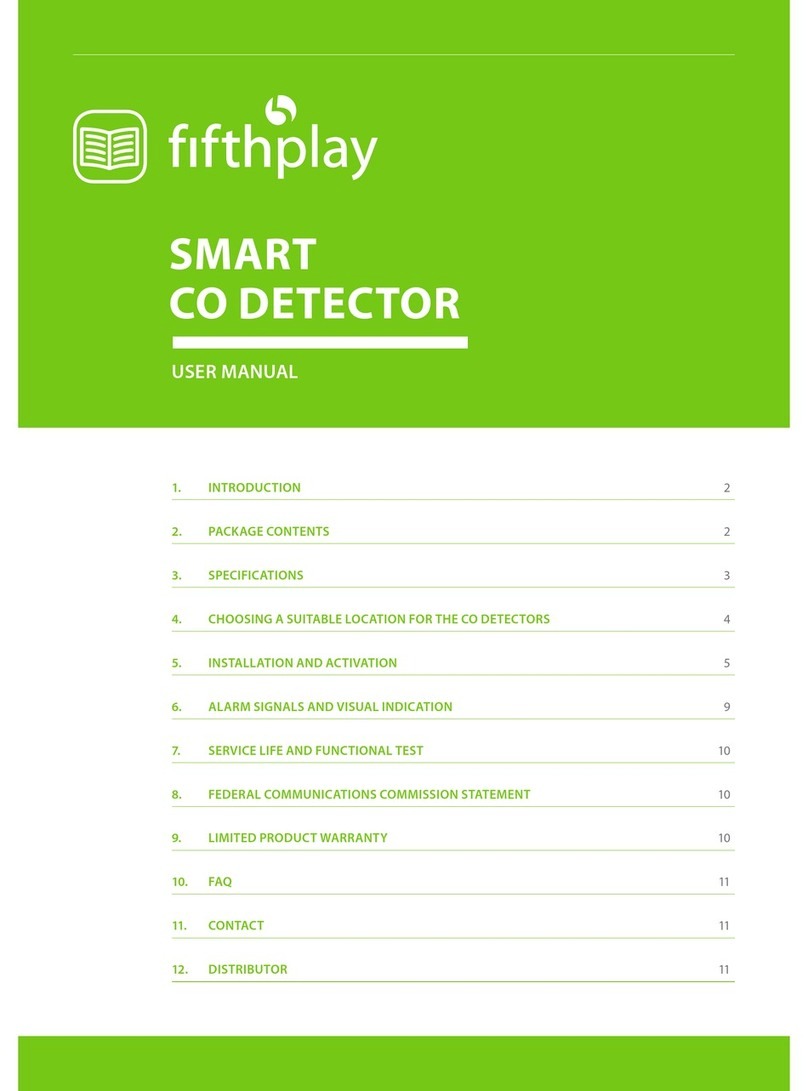
fifthplay
fifthplay Z-Wave user manual
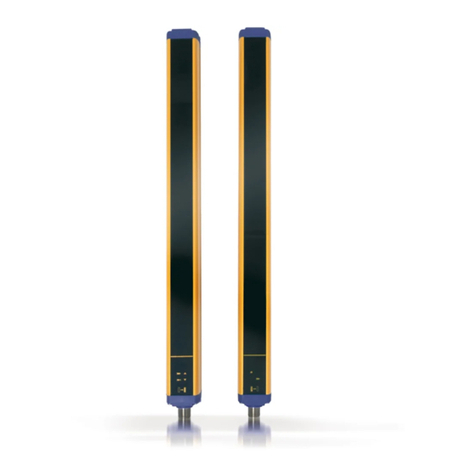
Datalogic
Datalogic SG4-30-015-OO-E instruction manual
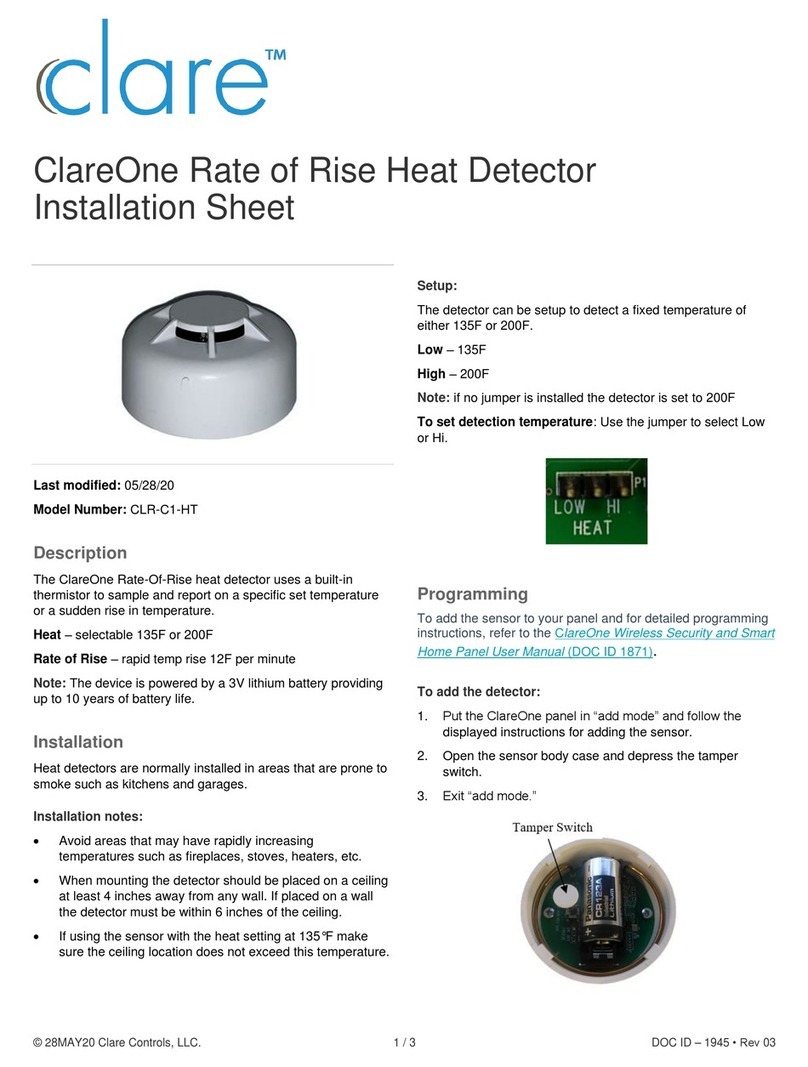
clare
clare ClareOne Rate of Rise Installation sheet
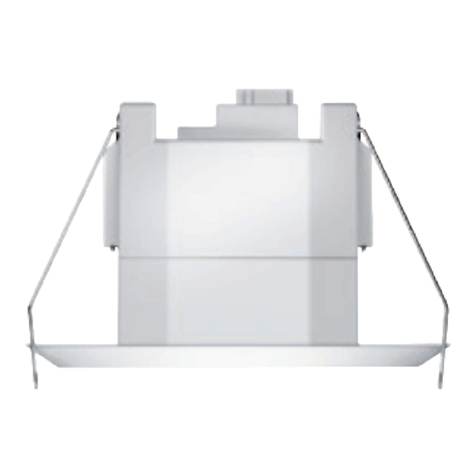
Theben
Theben theRonda S360 KNX UP WH instructions

Elektrotechnik Schabus
Elektrotechnik Schabus SHT 5000 operating instructions
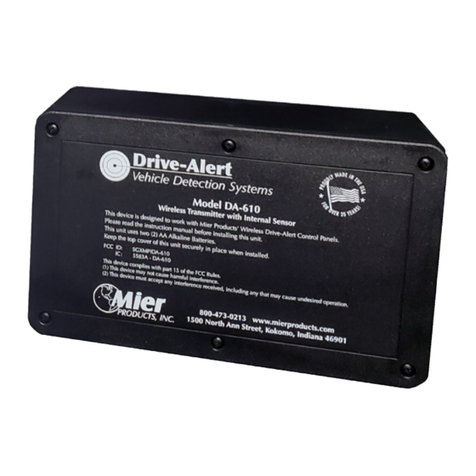
Mier
Mier Drive-Alert DA-700 instruction manual
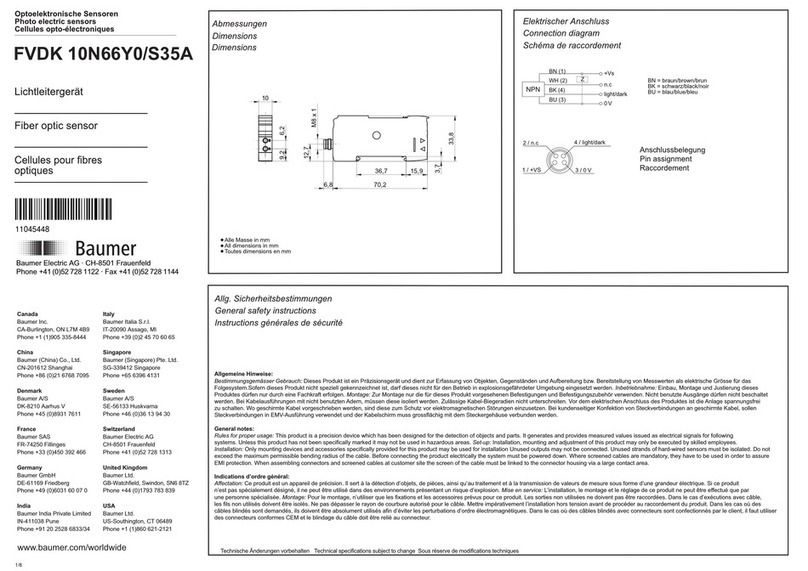
Baumer
Baumer FVDK 10N66Y0/S35A quick start guide

Ecosense
Ecosense EcoQube Pro EQ200 user guide

VOLTCRAFT
VOLTCRAFT IRF380-20D operating instructions
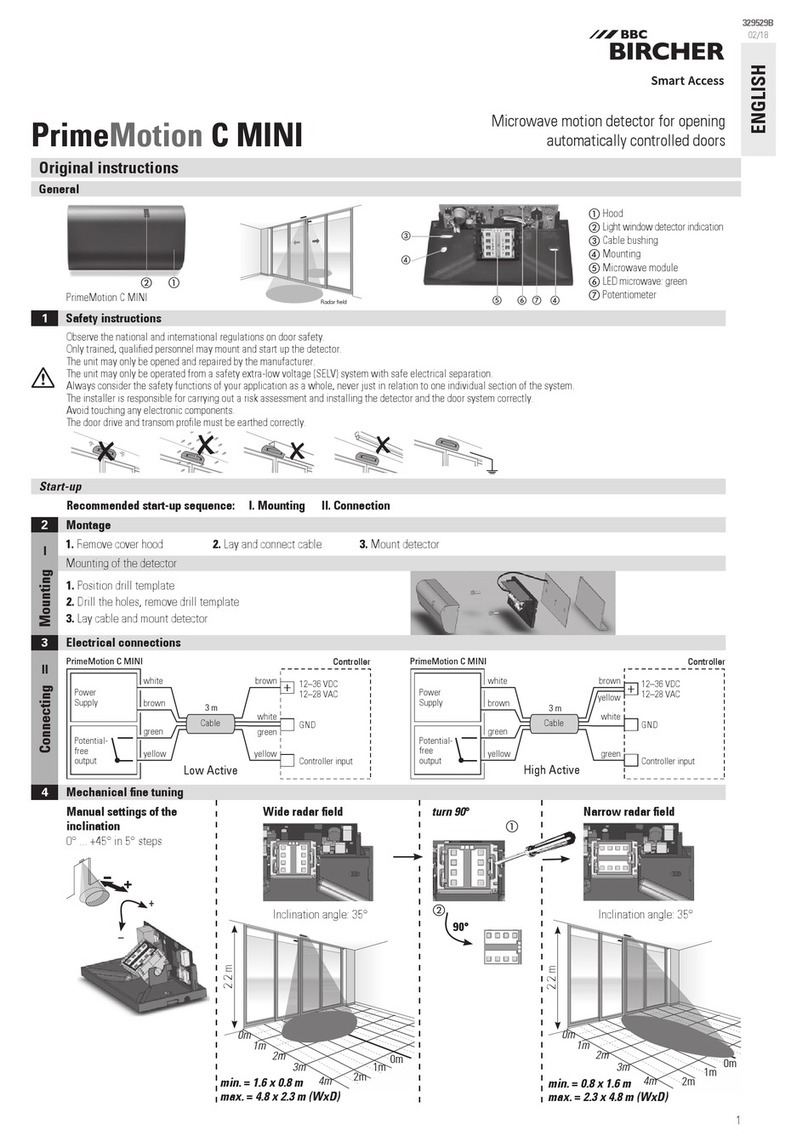
BBC Bircher
BBC Bircher PrimeMotion C MINI Original instructions
